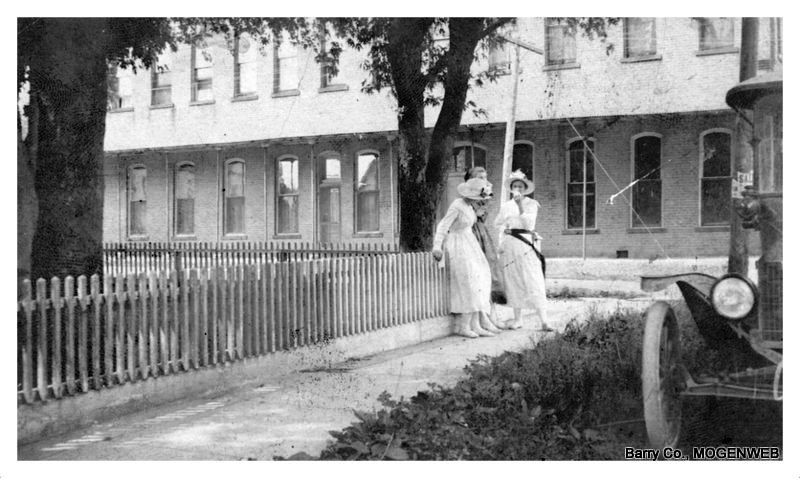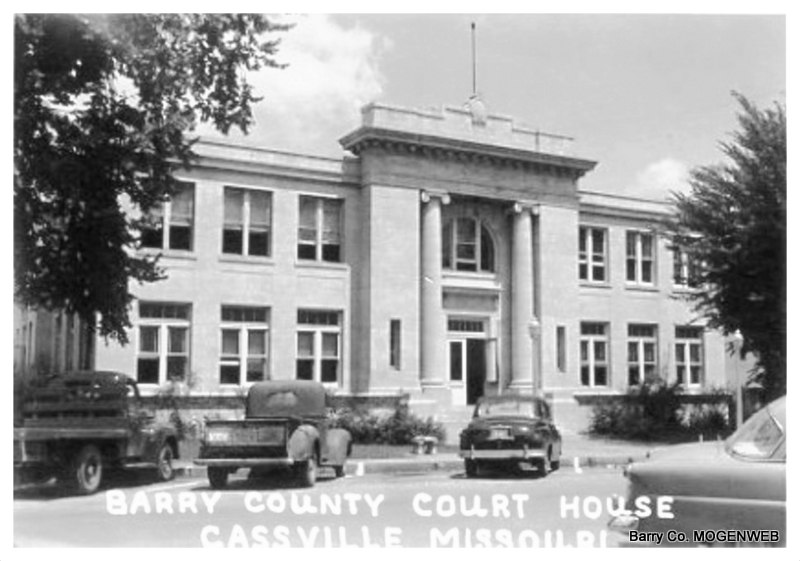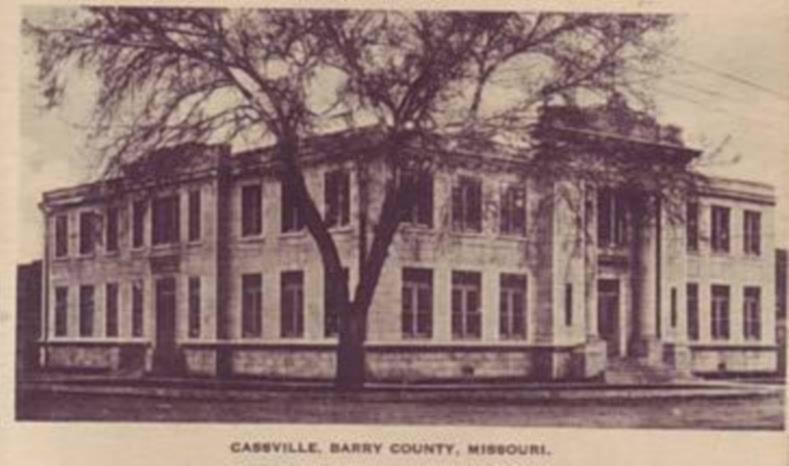Historical - Indian Removal
McMurty's Spring - Stop for Cherokees on Trail of Tears
Under Andrew Jackson, the Indian Removal Act of 1830, asked that not only the Cherokees
be taken to Oklahoma, but that the five civilized tribes be removed. The forced relocated of the Cherokee began in 1838. Land was given west of the
Mississippi for land that they owned in the eastern part of the US, most of which was in Georgia and part of the Cherokee Nation. Around 15,000 American
Native Cherokees were taken from their homes and driven west. The journey known as The Trail of Tears - 'the trail where we cried' was devastating to
these families. About 4,000, out of the 15,000 that were rounded up died in route. The Choctaw were the first to march the trail.
Historical
Indian Removal
Cassville Democrat, Saturday, Feb. 21, 1920
Indians in Barry County
Little do the present generation of people of Barry County know of the doing in the county, back in 1837, but in a
recent number of the Missouri Historical Review it gives an account of the State Militia being organized by state authorities to remove Osage Indians
from Barry County. Gov. Boggs was then governor of this date and he ordered Adjutant General R. M. Lisle to organize the 83rd regiment of Barry County
and address him on Nov. 29, 1837.
Maj. General Powell of 7th division of Mo.
Militia was ordered to proceed to Barry County and organize a company of
militia, to be armed and equipped, to range on frontier of the county, until
superseded by U. S. troops for the purpose of removing any Indians found
hunting or roaming within the limits of the state, for protection against
depredations.
J. T. Shanks, Brigade Inspector certified
that he had proceeded from Springfield, Mo., to Mount Pleasant, the county
seat of Barry County, and had there mustered into the service 100 volunteers
and it is thought that being the last company organized, that the following
were its officers: Capt. Levi A. Williams, Lieut. M. G. Campbell, Ensign A.
Looney and Serg. Alex. Morgan.
It is said that this company continued in service 18 days.
It has always been our understanding that it was the Delaware Indians that roamed and hunted over this section of the
country, as the late James Brixey, a former resident of this county, told the writer that he had hunted with the Delaware Indians in this county, in
his younger days and that he and a young Delaware Indian exchanged guns, a mark of esteem, as they were leaving this section on their way to the Indian
Territory, in the McCary hollow near were Joseph McCary now resides, about 3 3/4 miles southwest of Cassville.
Companies were also organized in Greene and
Stone Counties for the same purpose. |
The report that the bond proposition had
carried had reached the most distant parts of the county by Monday noon. Farmers were busy with their harvest and their plowing but in many places
these tasks were put aside when then news of victory came and they at once started to the county seat to rejoice over the most complete victory the
farmers of Barry County ever owned.
At five o'clock a large number of citizens of Wheaton and community lead by the Wheaton band arrived. This was the first the people of Cassville knew
that there was to be something doing in town that night. Until late in the evening citizens were coming from far and near and by eight o'clock the
court house park was filled. The citizens of Cassville were completely surprised but a program was hastily made consisting of singing, of music by
the Wheaton band and of extemporaneous speaking.
Judge McNatt of Aurora, Silas McQueen of Wheaton, George Edgar of Monett, James Sapp and W. E. Hankins of Butterfield, G. W. Irby of Jenkins, R. A.
Ellis of Ozark Township, George Hailey of Cato, O. D. Davis of Washburn, Judge O'Dwyer of Purdy, S. J. Salyer, A. L. Galloway, Rev. J. T. Brattin and
J. S. Davis of Cassville, Wm. Houston and Fran Archibald of Purdy all made excellent talks. Each speaker was given all the time he wanted and nothing
was said that would cast a reflection upon any town or any citizen of the county.
Celebrations were held in several other places in the county. It is the greatest victory Barry County ever gained and the people are rejoicing as they have never before over the result of an election. |
Early Navigation
- Roads used by early pioneers were the Old Wire Road
but the earlier settlers came by boat. They went up to the Mississippi
River where they boarded a boat down to where the Arkansas River empties
into the Mississippi up to the Arkansas to White River and then up the
White River to Barry County. Many early pioneers landed somewhere near
Eagle Rock after their river ride.
- One of the early roads referred to often was the
Sarcoxie Road. It ran from Springfield west to Sarcoxie. The Bull Creek
Road ran south into Taney County from the Springfield area. The Ozark
Trail was a popular path to take and was later called the Old Wire Road.
It ran from Springfield in a southwesterly direction through Cassville and
on down to Fort Smith, AR. It was called the Indian Trail sometimes.
- It wasn't until around 1870 or 1880 that sidewalks
were built of stone in the city of Cassville. The early ones were wood and
they ran in front of the business places.
- In 1909 the Barry County Atlas gives important
information abut our roads. It indicates that the Old Wire Road ran north
and south. The Exeter Road later became First Street and it is shown as
running west. The Galena Road was one that ran east of Cassville. The road
between Monett and Cassville was called the County Farm Road. It is
sometimes mentioned in the early newspapers.
- In the early newspapers it was reported that the
"Good Roads" meetings were held in Cassville. They were made up of
concerned citizens who wanted to improve the roads of Barry County and
were held prior to the coming of state highways.
- In 1920 the survey work began on the new state
highway that was to run from Monett to Seligman. This was the first time
that the state played a part in the roads of Barry County. In the early
Barry County newspapers this road project was referred to as the 'White
Way'. But that term could have been a colloquial one and not an official
one used by the local government.
- The survey work began in 1925 for Highway 76. It was a gravel road and wasn't blacktopped until later.
- In the 1930's the city began constructing hard surfaced streets in Cassville. Before that streets were sometimes muddy and in poor repair. The early newspapers have many items concerning the
condition and care of the city streets. Home-made, horse drawn drags were often used to smooth out the mud and make the streets passable.
|
Early Education
- In the early days Barry County schools were held in
the homes. They were referred to as subscription schools. The parents paid a sum of money to the teacher for each year their children attended school.
- The first formal school in Cassville was in 1848. It was located on Paint Street, later to be called East Street. There was a
deed for land made but there is no mention of a building.
- Prior to the Civil War the children of Barry County were educated in the family residences of the area. It is thought that
school houses came into being around 1868 or 1869. The school bell on the square in Cassville dates back to 1868 and the first school records are
dated April of 1869.
- The first school building in Cassville was constructed after the Civil War. In 1874 records indicate that religious
groups used the school house for religious purposes. A large school building was constructed in 1886. It was a two story building and had a
bell tower.
- In 1939 the year book had photos of the school and gym. Cassville 1939
Cassville Books
- The First 150 Years in Cassville, Missouri, by Senator Emory Melton
|
Cassville Hospital Post Card

Photo Restored by Gary Ball & Submitted by:
Linda Stephens McCormick
Cassville Post Card - Reads on back: "Dr. Mary lives in the tip-top of this"
The Cassville Hospital was the former LeCompte residence on north Main Street in Cassville, built c.1880's. Dr. George Newman converted
it to a hospital in the 1930's. In 1939 "Dr. Mary" Northcutt began a medical practice in Cassville, married Dr. Newman, and together they operated the
Barry County Hospital until his death in 1949. Dr. Mary closed the hospital about 1950, and the building was demolished in the mid 1950's. |
Cassville School Photos
Cassville Yearbooks School Book Pages Here: School Book
Cassville Links
Cassville Democrat Newspaper
Cassville Chamber of Commerce |





